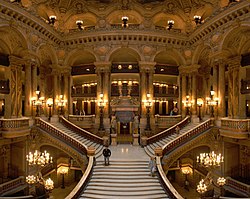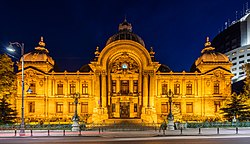
Beaux-Arts architecture
Neoclassical architectural style / From Wikipedia, the free encyclopedia
Dear Wikiwand AI, let's keep it short by simply answering these key questions:
Can you list the top facts and stats about Beaux-Arts architecture?
Summarize this article for a 10 years old
SHOW ALL QUESTIONS
Beaux-Arts architecture (/boʊz ˈɑːr/ bohz AR, French: [boz‿aʁ] ⓘ) was the academic architectural style taught at the École des Beaux-Arts in Paris, particularly from the 1830s to the end of the 19th century. It drew upon the principles of French neoclassicism, but also incorporated Renaissance and Baroque elements, and used modern materials, such as iron and glass. It was an important style in France until the end of the 19th century.
Neoclassical architectural style
Top: The Grand staircase of the Palais Garnier (Paris), 1860–1875, by Charles Garnier; Second: The CEC Palace on Victory Avenue (Bucharest, Romania), 1897–1900, by Paul Gottereau;[1] Third: Entrance of the Grand Palais (Paris), 1900, by Charles Girault; Bottom: Grand Central Terminal and the Helmsley Building (New York City), pictured in 1944. |



